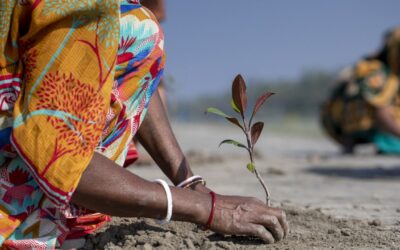Involving the local communities and government is key to the success of mangrove afforestation projects

FRIENDSHIP NEWS DESK
July 28, 2021
In Belgium, Luxembourg and Germany, catastrophic flash floods claiming hundreds of lives leaving landscapes looking like warzones; in China, a year’s rainfall in just three days; North America on fire—today, unusual climate events have become the norm. Bangladesh is not only at the forefront of the impacts of climate change, but it also holds many solutions for adaptation and resilience as we enter an era of escalating climate crisis.
One of these unique assets in Bangladesh is the largest mangrove forest in the world, the Sundarbans. Mangroves are unique and diverse coastal ecosystems that store many times as much carbon as any other type of forest. On the International Day for the Conservation of the Mangrove Ecosystem, Bangladesh Forest Department, International Union for Conservation of Nature (IUCN) and Friendship jointly arranged an international conference on Collaboration Between Government, NGOs and Communities in Mangrove Afforestation and Conservation.

Besides contributing to carbon neutrality by quickly absorbing carbon, mangroves are economically essential to indigenous communities by supporting activities such as crabbing, fishing and honey collection. Ahead of COP26, the year’s largest climate summit in Glasgow, this symposium was an effort to add momentum to mangrove afforestation in the global climate conversation. It focused on the key issue of collaboration with local communities and the government in afforestation projects.
Friendship has begun reforestation work on more than 100 hectares of mudflats surrounding coastal villages. The project is designed and implemented with close involvement of resident communities, who must sacrifice from their public spaces the land on which the trees are to be planted, and must also be involved in the caretaking of plants, keeping their animals from destroying the saplings, or damaging fences for ease of movement of their boats. As these mudflats are extremely fertile, the populations will derive more resources and benefits if there is a mangrove forest than if they individually exploit a bare land. The projects are also versatile, and there are efforts on an ongoing basis to make the plantations easier for residents to manage.

Meanwhile, caretakers for the project are trained and recruited from within the resident community, creating jobs. The community is informed of the vision behind the project, and the expected environmental and economic outcomes, including those that would directly benefit residents. “When these trees are older, they will provide fruits and fallen leaves and branches for firewood,” said Reshma Begum, a resident of Parshekhali in Shyamnagar, a village adjacent to the Sundarbans who was present at the conference.
Nature-based solutions
Dr. Khalid Hossain, program coordinator of the Bangladesh Country Office of the International Union for Conservation of Nature (IUCN) said that one of the focus points of the upcoming COP26 is nature-based solutions to the climate crisis, of which mangrove reforestation is a prime example. He pointed out that many individual projects had attempted mangrove reforestation, but these were scattered efforts that lacked coordination. The speakers at the symposium agreed on the need for organisations to work closely with the government, local communities and other NGOs to ensure continuity and cohesiveness in their efforts.
Reshma was given the opportunity to address Bangladesh’s deputy minister for environment, forest and climate change, Habibun Nahar, who was the chief guest at the event. She said that the Sundarban was much like a parent to her community, because they get so much from the forest.
The deputy minister acknowledged the forest’s relationship with the nation’s people. “The Sundarbans have nurtured our forefathers, they were dependent on the forest, and raised their families with resources they got from it. And that relationship is still alive today,” she said. “It is a grief that the Sundarbans has been affected several times by cyclones and due to lack of collective responsibility to take care of the forest. Our purpose today is to preserve the ecosystem so that we can leave a habitable earth to the next generation.”
“We all know that economic growth in a country like ours must happen,” said Runa Khan, Friendship founder and executive director. “But we can be an example to the world by taking exemplary action and ensuring our industry expansions and economic growth are environmentally controlled, and growth does not come at the cost of the survival of our environment.”
If you would also like to play a personal part in preserving the environment through the use of mangroves, make sure to:




